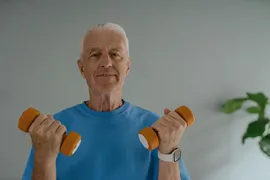In Germany, approximately three million people suffer from heart failure, also known as cardiac insufficiency – and the trend is rising. The primary drivers of this condition include obesity, high blood pressure, and diabetes. For those affected, it often means significant limitations in quality of life. Symptoms include shortness of breath during physical activity, making even simple tasks like climbing stairs challenging. Early diagnosis and appropriate therapy are therefore crucial to improving the well-being of patients.
Heart failure is a condition where the heart can no longer pump enough blood and oxygen throughout the body. It is categorized into two main types: heart failure with reduced ejection fraction (HFrEF) and heart failure with preserved ejection fraction (HFpEF). In HFrEF, the heart’s pumping ability is compromised, often due to damage such as a heart attack. In HFpEF, stiffening of the heart walls reduces blood circulation.
Although pharmacological therapies are well-established, data still indicate a high disease burden. A promising approach to addressing this issue is physical exercise, as demonstrated in the "Ex-DHF Study," led by Prof. Dr. Martin Halle, head of the Chair of Preventive Sports Medicine and Sports Cardiology. The study’s findings, funded by the German Research Foundation, have been published in the prestigious journal Nature Medicine under the title, "Combined endurance and resistance exercise training in heart failure with preserved ejection fraction: a randomized controlled trial." The journal boasts an impressive impact factor of 58.1.
"Our goal was to investigate the effectiveness of a combined training program of endurance and resistance exercises for patients with HFpEF," summarizes Prof. Halle. "We aimed to demonstrate how structured exercise, in addition to optimal pharmacological therapy, can improve physical performance and quality of life."
The randomized study involved 322 HFpEF patients, with an average age of 70, from 11 study centers in Germany and Austria. All participants received medication and were assigned either to a combined training program or standard therapy. The training group initially engaged in moderate cycling exercises three times per week, later supplemented with resistance training. The exercises were first conducted under professional supervision and subsequently continued at home. After 12 months, the “Modified Packer Score” was evaluated as the primary endpoint. This composite score includes six clinically relevant parameters, such as mortality, hospitalizations, and maximum oxygen uptake.
The results revealed no significant differences in the combined endpoint between the two groups after one year. However, patients who consistently adhered to the training program demonstrated significant improvements in maximum oxygen uptake, physical performance, and quality of life. Maximum oxygen uptake (VO2peak) is considered a key prognostic parameter for long-term health.
"The study highlights the importance of physical exercise, particularly the combination of endurance and resistance training, as a supplement to pharmacological therapy in HFpEF," explains Prof. Halle. "The effects were especially pronounced in patients who trained regularly, showing a significant increase in physical performance and an improvement in subjective quality of life."
However, only about 40% of patients adhered to the training program, which included activities such as walking or bodyweight resistance exercises at home. Prof. Halle concludes: "This underscores the challenges of establishing exercise as a therapeutic intervention. Physical activity can offer advantages over medication, but it is essential to ensure that patients remain motivated for the long term. Nevertheless, the study demonstrates the need for physicians, patients, and health insurers to rethink holistic approaches to treatment."
To the homepage of the Chair of Preventive Sports Medicine and Sports Cardiology
About the Study: “Combined Endurance and Resistance Exercise Training in Heart Failure with Preserved Ejection Fraction: A Randomized Controlled Trial”
Contact:
Prof. Dr. Martin Halle
Chair of Preventive Sports Medicine and Sports Cardiology
Georg-Brauchle-Ring 56
80992 Munich
Tel.: 089 4140 6774 (Klinikum rechts der Isar)
Phone: 089 289 24441 (Uptown Campus)
E-Mail: Martin.Halle(at)mri.tum.de
Text: Bastian Daneyko
Photos: pexels/private

